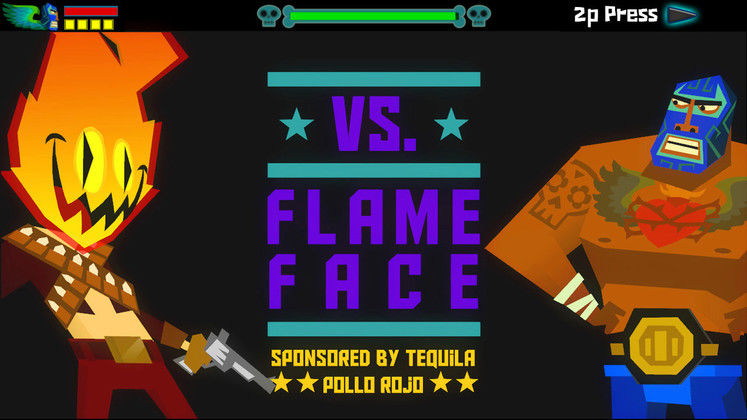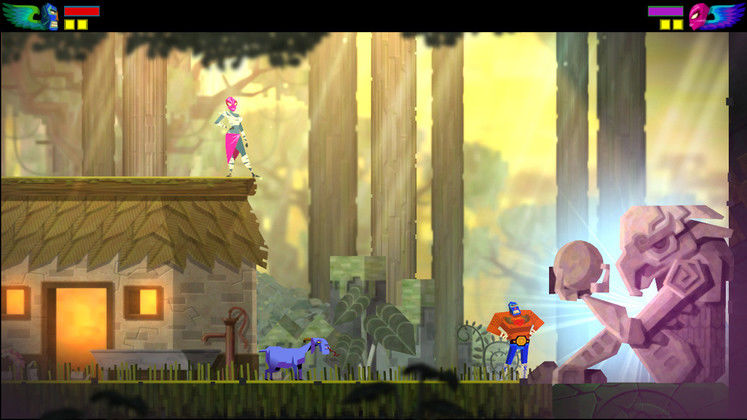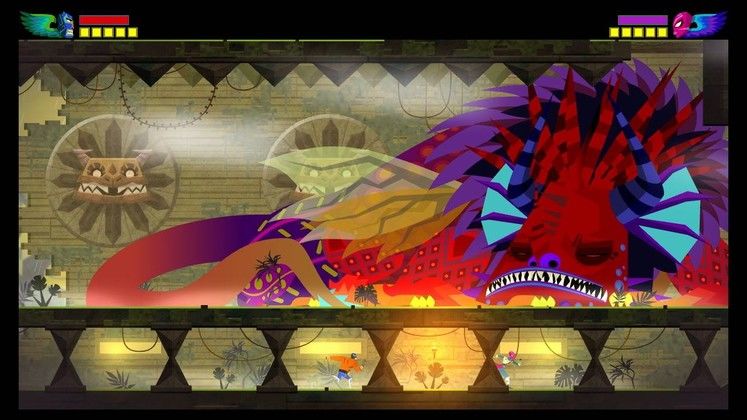Like so many downloadable games as of late, much of the joy when playing Guacamelee! comes from the references to other games of the genre. Homages to the way you collect new abilities and progress in games like Metroid are commonplace, and the hero searching for the Princess narrative makes for plenty of obvious references along the way. Rather than feel forced like some gaming references often do, it gives Guacamelee! a warm tone throughout, a welcoming nod to ages past whilst pushing the genre to some interesting new places.
 |
| The bosses you encounter provide much of the humour in Guacamelee as well as being the most difficult moments of the game |
The setting itself is vibrant and detailed; it's hard to find a comparison on the market right now. The 'Day Of The Dead' style explores various aspects of Mexican culture, bundled together with a tongue and cheek narrative featuring an exuberant cast of characters. Juan Aguacate's journey to save El Presidente's daughter from bad guy Carlos Calaca, obviously an evil Charro Skeleton, is one of the most light-hearted and enjoyable narratives a PSN game has ever seen.
Combat is integral to Guacamelee!, both in terms of the enclosed battle segments that make up much of the game, and also the platforming you perform between each of these encounters. Juan learns a new ability or two in each of the 12 areas you explore in the game, each skill allowing you to progress to areas previously locked away. Unlike most Metroidvania games, which separates these exploration related skills from those used in battle, here you find yourself having to use abilities in unexpected ways to make progress. For instance the first combat manoeuvre you learn, the Rooster Uppercut, is certainly very useful in combat allowing you to hit the enemy into the air to continue a combo. Its main use though happens to be when trying to reach a higher platform. Giving you that extra boost towards an upcoming ledge, it feels like you are cheating at first. It's an interesting quirk, one that is much more noticeable than you would expect it to be, you can often save yourself from falling by being lucky with a quick press of the square button.
This comes at a price though and once you reach around the halfway point of the game, with enough skills that you have to think about which combination you want to pull off, the game ends up feeling more like a continuous set of puzzles than a regular side-scroller. There were so many times that I found myself throwing the controller onto the floor in frustration with some of the platforming puzzles, the timing and precision required for some of them can feel impossible at times.
 |
| You uncover new abilities by destroying sacred status scattered across the game |
Throw in the most important aspect of the game, the ability to switch between the Living World and the Dead World on the fly, where certain platforms, walls and enemies only appear in one of the two, and you have one of the most fiddly games I've played in years. You'll need to be extremely dexterous with your button presses in order to explore everything that Guacamelee! has to offer, especially as the combat sections can get just as complicated. You'll be switching between worlds, alternating between 4 different attack patterns all matched to the square button, the battles are more similar to a fighting game than a typical side-scroller. During each of these fight sequences your surroundings are enclosed by walls, you must defeat all enemies to progress. It ramps up the pressure but thankfully checkpoints are plentiful; throughout Guacamelee!.
Adding to the already stellar content on offer in Guacamelee! is a full same screen co-op mode, which features a playable female alternative to Juan. What makes this mode extra special is that thanks to the cross play functionality of the game, you get a copy of the game for PlayStation Vita as well as PS3, the second player can use either a second controller or their Vita. It's a neat touch, and the game looks just as good, if not better on the smaller Vita screen. When not being used for a second player, you can use the Vita as an interactive map screen something that helps to no end in a Metroidvania title such as this (where was a map like this back when we needed it for Super Metroid!). Vita integration is just another example of how developers Drinkbox Studios have taken a classic genre and updated it for the current gaming market.
 |
| The art design is incredible throughout, character designs being especially expressive |
The most impressive thing about Guacamelee! is just how well it stands when compared to the classic Metroidvania titles of old. You feel the excitement that comes with exploring, the game crafted in such a way where you always feel in control of where you are headed. Even when the game is secretly pushing you in the direction it wants you to, you don't notice you are following a set path at all. It's something that made games like Super Metroid so memorable, the experience feels like it belongs to you, even if differences will be very slight when comparing two playthroughs. The game's length is probably the one thing that will put some genre fans off, at less than 5 hours on a first playthrough it doesn't stand up against other Metroidvania titles in this respect. That said, the game is never tiresome, you are constantly moving forward with someplace to be or someone to defeat and so these are 5 hours you won't regret spending with Guacamelee!.
GUACAMELEE! GOLD EDITION VERDICT
One of the best games to come to PSN in ages, Guacamelee! is one of those rare titles that bridges the gap between the familiar and originality perfectly with some of the most vibrant and stylish graphics of the year. If you own both a PS3 and a Vita this is essential, and well worth a look even if you don’t.
TOP GAME MOMENT
Finally mastering a platforming section that you’ve had to replay a hundred times already certainly feels great.




